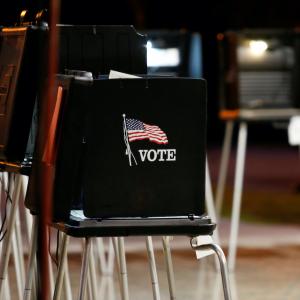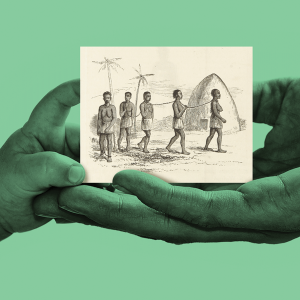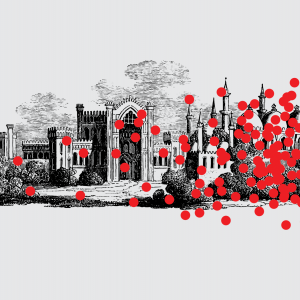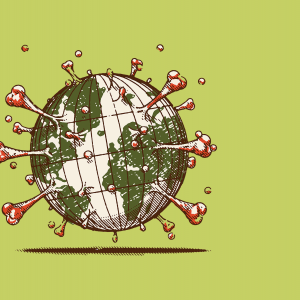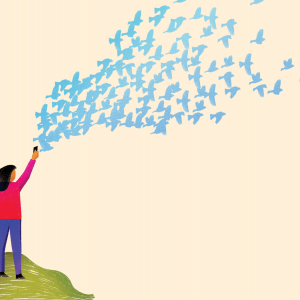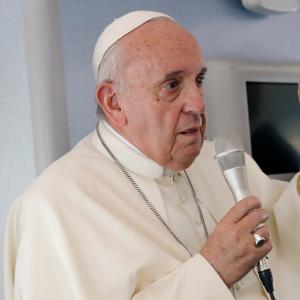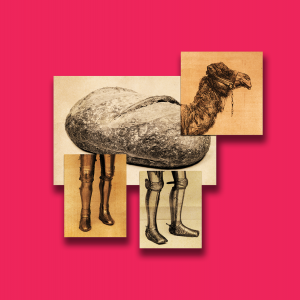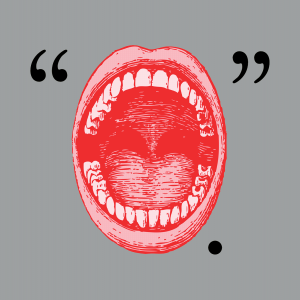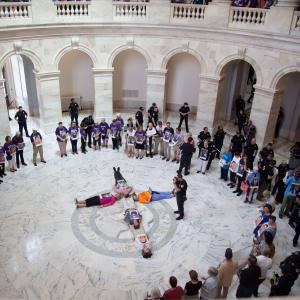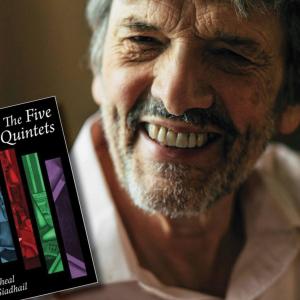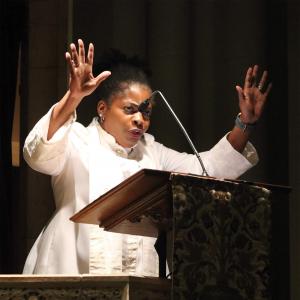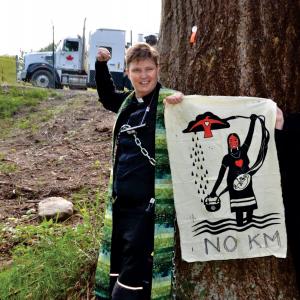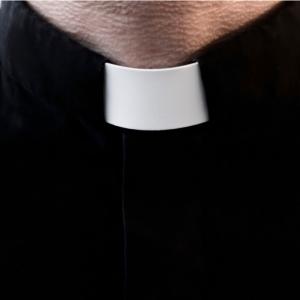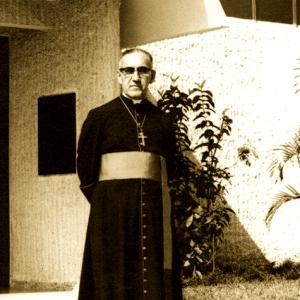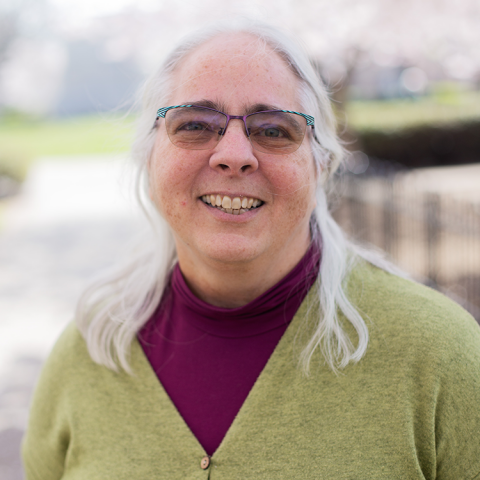
Rose Marie Berger is a Catholic peace activist and poet. She has been on Sojourners staff since 1986, and worked for social justice movements for 40 years. Rose has rooted herself with Sojourners magazine and ministry. She has written hundreds of articles for Sojourners and other publications and is a sought after preacher and public speaker. After living in Washington, D.C., for 35 years, she moved to Oak View, Calif., in 2022.
Rose’s work in Christian nonviolence has taken her to conflict zones around the world. She is active in the Catholic Nonviolence Initiative, a project of Pax Christi International, and served as co-editor for Advancing Nonviolence and Just Peace in the Church and the World, the fruit of a multiyear, global, participatory process to deepen Catholic understanding of and commitment to Gospel nonviolence. Her poetry has appeared in the books Watershed Discipleship: Reinhabiting a Bioregional Faith and Practice and Buffalo Shout, Salmon Cry: Conversations on Creation, Land Justice, and Life Together. She is author of Bending the Arch: Poems (2019), Drawn By God: A History of the Society of Catholic Medical Missionaries from 1967 to 1991 (with Janet Gottschalk, 2012), and Who Killed Donte Manning? The Story of an American Neighborhood. She has also been a religion reviewer for Publishers Weekly and a Huffington Post commentator. Her work has appeared in National Catholic Reporter, Publishers Weekly, Religion News Service, Radical Grace-Oneing, The Merton Seasonal, U.S. Catholic, and elsewhere. She serves on the board of The International Thomas Merton Society.
With Sojourners, Rose has worked as an organizer on peace and environmental issues, internship program director, liturgist, community pastor, poetry editor, and, currently, as a senior editor of Sojourners magazine, where she writes a regular column on spirituality and justice. She is responsible for the Living the Word biblical reflections on the Revised Common Lectionary, poetry, Bible studies, and interviews – and oversees the production of study guides and the online Bible study Preaching the Word.
Rose has a veteran history in social justice activism, including: leading the first international, inter-religious peace witness into Kyiv, Ukraine, following the outbreak of war in 2022, organizing inter-religious witness against the Keystone XL pipeline; educating and training groups in nonviolence; leading retreats in spirituality and justice; writing on topics as diverse as the “Spiritual Vision of Van Gogh, O'Keeffe, and Warhol,” the war in the Balkans, interviews with Black activists Vincent Harding and Yvonne Delk, the Love Canal's Lois Gibbs, and Mexican archbishop Ruiz, cultural commentary on the Catholic church and the peace movement, reviews of movies, books, and music.
Rose Berger has taught writing and poetry workshops for children and adults. She’s completed her MFA in poetry through the University of Southern Maine’s Stonecoast program. Her poetry has been published in Sojourners, The Other Side, Radix and D.C. Poets Against the War.
Rose grew up in the Central Valley of California, located in the rich flood plains of the Sacramento and American rivers. Raised in radical Catholic communities heavily influenced by Franciscans and the Catholic Worker movement, she served for nine years on the pastoral team for Sojourners Community Church; five as its co-pastor. She directed Sojourners internship program from 1990-1999. She is currently a senior editor and poetry editor for Sojourners magazine. She has traveled throughout the United States, and also in Ukraine, Israel/Palestine, Costa Rica, the Netherlands, Northern Ireland, Bosnia, Kosova, Peru, Colombia, Venezuela, and El Salvador visiting primarily with faith communities working for peace in situations of conflict.
Rose was born when atmospheric CO2 was at 319.08 ppm and now lives with her wife Heidi Thompson in Oak View, Calif., in the Ventura River watershed on traditional Chumash lands. Learn more at rosemarieberger.com.
Rose’s articles include:
- Pursuing the Secret of Joy: What is joy when it's not promiscuously tied to happiness, Hallmark, or hedonism?
- Why Our Faith Delegation went to Ukraine?: Our public message was simple: “We have come to Kyiv in solidarity to pray for a just peace.”
- Nonviolence in Najaf?: Will we recognize an Islamic peace movement when we see it?
- Of Love's Risen Body: The poetry of Denise Levertov, 1923-1997
- Glimpses of God Outside the Temple: The spiritual vision of Vincent Van Gogh, Georgia O'Keefe, and Andy Warhol.
- Damnation Will Not Be Televised: Almost everything I know about hell I learned from watching Buffy the Vampire Slayer
Speaking Topics
- Christian nonviolence, peace, war
- Catholic Nonviolence Initiative
- Climate change, creation care, watershed discipleship
- Bible study, liturgical year
- Poetry
- Spirituality and social justice
- Any topic covered in Sojourners magazine
- Catholicism
Speaking Format
- Preference for virtual events, but willing to discuss in-person events on case-by-case basis
Posts By This Author
Fratelli Tutti: A Remix of Pope Francis' Greatest Hits
‘We can only be saved together.’
Fratelli Tutti, Pope Francis’ encyclical on “social friendship” released in October, sounds like a new gelato flavor—something between fior di latte and tutti frutti. Like the Italian frozen dessert, Francis’ pastoral sections melt in your mouth—but a nutty, bitter crunch hides in every bite.
Encyclical letters are used by popes to address important issues. Recently, these letters have been addressed not only to Catholics, but to “all people of good will.”
Where Laudato Si’, released five years ago, developed new doctrine and broke ground in Catholic social teaching to address the fierce urgency of climate collapse, “On Universal Fraternity and Social Friendship” (as it’s called in English) counsels us not to backslide as a human family. Cardinal Michael Czerny said, “If Laudato Si’ taught us that every thing is connected, then Fratelli Tutti teaches us that everyone is connected.”
We Can Help Prevent an Election Crisis. Here's How
Seven concrete steps to safeguard the integrity of the vote
1. Get involved
Scenario: Voting places are closed, and mail-in ballots are restricted because there are too few election workers due to COVID-19 concerns.
Tip: Democracy is a team sport. Everyone can be an election worker. Commit a certain number of people from your church to register as poll workers and mobilize medical personnel to speak on coronavirus-safe voting practices. The U.S. Election Assistance Commission hosts a video explainer and training information for each state, and you can support efforts to recruit young poll workers through powerthepolls.org.
‘My Sixth Great-Grandfather Bought My Sixth Great-Grandmother’
Revisiting my entangled and complicit family history.
HOW CAN SOMEONE born white take on new flesh when they are old?
This is the question I hear when I read the story of Nicodemus during this Black Lives Matter moment amid the 400-year-long freedom struggle of Black people in the U.S. “How can someone be born when they are old? Surely they cannot enter a second time into their mother’s womb to be born!” (John 3:4). How?
In 1707, my sixth great-grandfather bought my sixth great-grandmother at a slave auction at a French military post in what is now Mobile, Ala. She, later “christened” Thérèse, was a 10-year-old Chitimacha girl. He, Jacques Guedon, was a 17-year-old from Nantes in Brittany who had been recruited into the French colonial navy.
The Chitimacha were the most powerful nation along the Gulf Coast. Prior to contact with Europeans, the Chitimacha lived in a sophisticated matrilineal culture of classes and clans that served them for more than 10,000 years—through disease, war, and climate changes. They vigorously and continually defended their homeland against incursions and slave raids by English, Spanish, and French military, migrants, and missionaries. Today, they are the only tribe in Louisiana to still occupy a portion of their aboriginal homeland.
But a young French-Canadian commander named Bienville was tasked with establishing a fort at Mobile and defending it against the English. He needed to make alliances with native nations—primarily the Chickasaw and Choctaw—or severely weaken those that refused. To accomplish these twin goals and build up his personal wealth by selling Indian slaves, Bienville led his regiment in a night raid on Thérèse’s village. Likely all the adults were massacred. The dozen or so children left alive, including Thérèse, were rounded up for sale. It was a minor skirmish in France’s half-hearted attempt to establish and maintain extractive trade routes for maximum profit and minimum outlay, an expedient conquest to boost political standing and pay off debts.
Christianity's First Pandemic Sounds Eerily Familiar
In the sixth century all worship was suspended, people hoarded, and survivors bore the economic burdens.
THE HORROR JOHN of Ephesus witnessed in north Africa and Constantinople was so traumatic that it took him three years before he could begin to tell the story.
“Thy judgments are like the great deep,” prayed John of the “cruel scourge” that struck the whole world in 544 C.E., when the plague spread along the trade routes of Europe, the Middle East, and Africa. “Like the two edges of the reaper, it successively passed across the earth, and progressed without stopping,” wrote John. The cities stank with unburied corpses. This sixth century deacon and hagiographer wrote, “The mercy of God showed itself everywhere toward the poor, for they died first while everyone was still healthy enough to ... carry them away and bury them.”
No wonder John drew upon the psalms of lament and the “weeping prophet” Jeremiah for guidance. His congregation was dead or dispersed. To anoint and bury the dead meant contamination. All worship was suspended. The normally scrupulous were hoarding and stealing. And rulers who had overspent on imperial expansion placed impossible economic burdens on the survivors.
And then it all happened again 14 more times throughout north Africa—because pandemics recur in waves, sometimes for as long as 200 years.
What World is Possible After the Pandemic?
The coronavirus has forced a global sabbath. Will it also lead to a global Jubilee?
WE DON'T KNOW the full extent of the coronavirus pandemic. We know of the many who have died as a direct result of infection. We know that whole countries have turned on a dime to shield themselves from the shadow of death as it passes over. We don’t know where it will lead.
In the wake of Hurricane Katrina, Rebecca Solnit wrote, “Horrible in itself, disaster is sometimes a door back into paradise, that paradise at least in which we are who we hope to be, do the work we desire, and are each our sister’s and brother’s keeper.” Solnit reminds us that disasters and plagues sometimes signal liberation.
COVID-19 has forced the human community into mourning. In our retreat from the work-a-day world, it has imposed a global sabbath and Jubilee. Staring into this “cruel scourge,” as John of Ephesus described the Justinian plague in the year 545 C.E., can we also see that another world is possible?
The Jubilee legislation found in Leviticus 25 lays out a vision for “social and economic reform unsurpassed in the ancient Near East,” according to Robert K. Gnuse. The Jubilee laws declared that Yahweh was the rightful owner of all the earth, and therefore all Israelites—rich and poor—have an equal right to its abundance, within limits. In an economic system based on land and its produce, this was a radical transformation. The legislation undercut wealth disparities by preventing land speculation and by mandating debt forgiveness and interest-free loans. Finally, it ordered the release of the enslaved and those in debtors’ prison.
There's Nothing Pro-Life About Trump
Trump's weaponization of whiteness and all-out assault on America’s working poor stand in stark contradiction to the “culture of life” that Catholics embrace.
WHITE CHRISTIAN VOTERS —evangelicals, but also Catholics—pushed Trump over the finish line in the 2016 election. Trump regularly holds court in the media with evangelicals but has been less overt with Catholics. That is until January, when he favored some with a personal appearance at the annual March for Life on the national Mall, held in protest of the 1973 Supreme Court decision that overturned state bans on abortion.
“Catholics were of secondary importance to the Trump campaign in 2016, behind evangelicals. That hasn’t changed, but there is at least an effort to reach this community now,” former Rep. Tim Huelskamp (R-Kan.) told Politico in January.
As a Catholic, I’m deeply troubled by this president. Trump stands against everything I’ve been taught to believe.
Pope Francis has prioritized the climate crisis for Catholics; Trump withdrew from the Paris accords and dismantled the modest advances made under Obama.
Pope Francis says welcoming migrants builds a strong social ethic; Trump implements policies that tear apart families and imprison migrant children.
Catholics believe in promoting a consistent moral stance that allows life to flourish. Under the Trump administration average life expectancy in the U.S. has been on the decline for three consecutive years (representing the longest consecutive decline in the American lifespan since World War I).
Pope Francis teaches that the death penalty is no longer permissible under any circumstance; Trump’s attorney general reinstated the federal death penalty, executing prisoners for the first time in nearly two decades.
The Gospel According to a TikTok Evangelist
Be fierce, creative, and practical in your desire to do good.
IF JESUS BROUGHT good news to the poor today, it might look like one of Shaunna Burns’ videos.
Burns is an honest-to-God evangelist on TikTok, the fast-growing, Chinese-owned, short-form video-sharing social network. Translate Jesus’ “brood of vipers” and “whitewashed tombs” into f-bombs and salty vernacular and you get Burns’ practical “good news” that’s changing lives.
A former debt collector, Burns knows all about the shady practices of collection agencies. But she didn’t start her 60-second “debt pro tips” on TikTok until she got a call herself from a collection agency harassing her for her daughter’s medical bills.
“Hey, guys. So, here’s some quick debt-collection pro tips,” North Carolina-based Burns starts in her first video in December. She then instructs the uninformed: It’s illegal for debt collectors to call outside of certain hours. Medical debt has a statute of limitations—usually three to six years—that varies by state. Always ask a collector for a copy of your original signed invoice.
Will We See Through the 'Fog of War' This Time?
The attack by a U.S. MQ-9 Reaper drone that fired missiles into a convoy carrying Soleimani was neither impulsive nor a retaliatory response. It was not undertaken to protect Americans. It was not an act of patriotism. It was not done to defend the U.S. embassy in Baghdad after the “dramatic but bloodless” siege. If anything, it was in response to Trump’s increasingly untenable situation at home.
Did Pope Francis Just Elevate These Anti-Nuclear Activists to Religious Prisoners of Conscience?
Two years after the Vatican State signed the Treaty on the Prohibition of Nuclear Weapons (currently ratified by 34 countries), he declared during an in-flight press briefing from Japan to Rome, “Not only their use, but also possessing them: because an accident or the madness of some government leader, one person’s madness can destroy humanity.”
Epiphany Is a Time for Imaginative Leaps
IMAGINE YOURSELF IN a darkened theater. At center stage sits a woman, child on her lap, both wrapped in tonal greys. A tiny stream of light falls from above. Off left, large animals shift their weight on floorboards, chuff-chuffing their breath; foreign tongues murmur them calm. Off right, the only sound is of metal rasps running repeatedly down the length of blades; random sparks flare off the cutting teeth. This is Epiphany. Everything is waiting to happen. We know the narrative detail: Mary and Jesus, a manger, the Magi’s star-trekking journey with camels and gifts to honor a “newborn king” (while Herod, like Pharaoh, plots a bloody offense). But Epiphany is a season for paradigm shifts. What if we scramble the details? Imagine this. Off left, the chuff-chuffing of foreign tongues come not from men calming beasts, but camels praying as they approach the child, the spiritual waterhole for the world. The camels have not brought kings or astrologers, but a guild of bakers, who extend platters of fresh bread toward the child. At center, the woman wrapped in a cloak of ultraviolet leans back on her stool: She has given birth to a star, filling them both with light. At her side stands a human child. He gazes off right. The sound of rasps and swords, boots and shouted commands fascinate him. Slowly, the child lets go his mother’s hand, relaxes his throat muscles, measures his breath. In a world of bread and circuses, he has made brothers of soldiers. He is a sword-swallower and eats their pain.
I Prayed The Rosary for Immigrant Children; I Was Arrested
Immoral legislation calls for our dignified rage.
“NO” IS A COMPLETE SENTENCE. I said it recently to a U.S. Capitol Police officer when he asked me to stop praying the rosary for immigrant children and to move. He then arrested me for “crowding, obstructing, or incommoding” in the rotunda of the Russell Senate Office Building in D.C.
That day the police arrested 71 Catholics. In the parlance of Christian nonviolence, we brought the spiritual power of our prayer to a site of mortal sin—specifically the offices of powerful lawmakers who support, through cowardly and often deliberate consent, caging immigrant children. The border patrol apprehended 69,157 such children at the U.S.-Mexico boundary between October 2018 and July 2019, seven of whom have died after being in federal custody.
What is the significance of Catholics and other Christians saying “no”? At its most authentic, religious faith builds moral muscles that push the human species to become more generous and just and guard against it backsliding into barbarity. While shallow religion shapes people for instinctive compliance to authority, ecclesial and secular, a deep faith tradition trains for moral discernment and formation of conscience and provides a narrative for how to resist immoral actions.
A Cross of Human Bodies
How 71 Catholics Were Arrested for Protesting Immigrant Child Detention
When the U.S. Capitol Police issued three warnings for us to disperse, most of those gathered stepped back behind the police line, but five stepped forward and laid down in the shape of a cross in the center of the rotunda. A cross of human bodies. Dozens more formed a eucharistic circle around this cross.
Challenging The Social Order at the Vatican
The logic of peace must always replace a logice of violence.
THE MAP is not the territory, wrote Polish scientist Alfred Korzybski, “but, if correct, it has a similar structure to the territory, which accounts for its usefulness.”
When I glanced through the participants list at the second Vatican consultation on nonviolence and just peace, I recalled Korzybski. The list was organized by ecclesial rank. Cardinals on top, followed by archbishops, bishops, monsignors, and reverend fathers. Next were women in religious orders, then male and female laity with titles, finally misters and Mses. My name was last.
President Trump Wants to Withdraw the U.S. from the International Arms Trade Treaty
Gun violence and small arms deaths disproportionately impact communities of color, women, and other marginalized groups. As the biggest arms exporter, the U.S. signature to the ATT demonstrated its support for the establishment of common international standards for all states in the global arms trade.
Spiritual Reflections on My Paycheck
How we spend our money is a topic for Christian discipleship.
MONEY IS TO Americans what sex was to Victorian England. We’ll read about others’ exploits, but rarely reveal our own.
In the mid-1980s, I joined the Sojourners base Christian community. I was in my 20s with little disposable cash and a modest college loan. My theological attitude was “love of money is the root of all evil” (1 Timothy 6:10)—even thinking about money risked sliding into America’s amorous relationship with capital.
Madame Jazz vs. Madame Guillotine
Irish poet Micheal O’Siadhail offers a reflection on the aftermath of Western modernity.
IRISH POET Patrick Kavanagh famously said, “Any poet worth his salt is a theologian.”
In The Five Quintets, a poetic tour de force by Micheal O’Siadhail, Kavanagh’s quip is flavorfully borne out. Quintets offers a sustained reflection on Western modernity (and its yet unnamed aftermath) in the vein of The Divine Comedy, Dante’s sustained reflection on medieval Europe (and its aftermath, the Renaissance).
O’Siadhail (pronounced O’Sheel) inspects 400 years of Anglo-Atlantic culture—artistic creativity, economics, politics, science, and “the search for meaning”—with the skillful hand of a citizen-poet, refracted through an Irish Catholic soul. Dublin born and educated, now poet in residence at Union Theological Seminary in New York, O’Siadhail embodies the vatic tradition of the Hibernian Gael—poet, prophet, priest, and, at times, jester.
His blind guide for the modern era is Madame Jazz—who encompasses klezmer from the Jewish shtetls and céilí music from famine Ireland as well. Jazz is the consummation of all that is truly human, the best of our polyphonic harmonies, a wild, joyful freedom born of shared suffering. Her chilling counterpoint, who ends the age of monarchs, is Madame Guillotine, whose shadow reaches forward into our War on Terror.
Power Dynamics and Sexual Ethics
An interview with Bishop Cynthia Moore-Koikoi.
UNITED METHODIST BISHOP Cynthia Moore-Koikoi has fond memories of growing up in the church. It helped form and develop her as a leader, she said. But her involvement with church administration and leadership came with a price, as she described in a panel at the Religion News Association conference in 2018. As a youth delegate to her annual convention, Moore-Koikoi recalled that whenever she walked by a certain group of clergy, “they were going to make comments about my physical appearance ... I learned how to turn my face quickly when that ‘holy kiss’ was given so that it would land on my cheek not on my lips. It was like I was walking a gauntlet at times.”
In 2016, Moore-Koikoi was consecrated as a bishop and called to serve United Methodists in western Pennsylvania. Certainly, she thought, serving in such a high church position and marriage would protect her from sexual comments and predation. But, says Moore-Koikoi, “no level of power or authority in the church can insulate persons from sexual harassment.” Sojourners’ senior associate editor Rose Marie Berger interviewed Moore-Koikoi by phone in December 2018.
Sojourners: In 2016 you were elected bishop. Have you experienced any sexualized pressure, harassment, or assault since your ordination as a bishop?
Bishop Cynthia Moore-Koikoi: Yes. There was an incident that happened not long after I was ordained a bishop that I characterize as sexual harassment. Unfortunately, it happened at one of the earliest meetings that I went to as a bishop with the Council of Bishops. An individual there made some inappropriate comments about me, about my physical appearance and about his desires. It was a very uncomfortable situation, [my] being a new bishop, not knowing how bishops conduct themselves at those kinds of things.
‘Because of my chains...’
Faith leaders in British Columbia are leading the way in ‘proclaiming the gospel without fear.’
WHAT DO YOU see in the photo at right? Name all the objects. Spend a moment.
Hillside erosion. A semi-trailer truck with sleeper unit and maple leaf logo. Chain-link fence. Two people. U-locks at necks. Banner. Ecclesiastical stole. Heavy-grade straight chain. Clerical collar. Tree trunk. Small orange ribbon.
What is the subject of the photo? What does the camera leave out?
Photographer Murray Bush took this photo last year on May 25 on Burnaby Mountain in British Columbia. The truck is for horizontal drilling and belongs to the firm Kinder Morgan, one of the largest energy infrastructure companies in North America. The company specializes in pipelines and petroleum terminals and is the first pipeline operator to purchase a fleet of oil tankers. The fence marks a boundary—and contested space.
The two people, Laurel Dykstra and Lini Hutchings, are members of Salal + Cedar, a Christian community in Coast Salish territory. The lock-on hardware around them—the U-locks and chain—is to delay removal by the 17 Royal Canadian Mounted Police who showed up. In 2015, the Anglican Diocese of New Westminster appointed Dykstra as a sort of “priest to the Fraser River watershed.”
No More Cover-Ups
It’s time for these idolaters to leave Catholic leadership.
I AM ROMAN CATHOLIC, and I want to apologize. Apparently, a portion of my church not only believes in but still practices child sacrifice.
The Pennsylvania grand jury report was clear. It opened: “We, the members of this grand jury, need you to hear this. We know some of you have heard some of it before. There have been other reports about child sex abuse within the Catholic Church. But never on this scale. For many of us, those earlier stories happened someplace else, someplace away. Now we know the truth: It happened everywhere.”
For more than 30 years, investigations around the world have revealed similar patterns in Catholic institutions. Priests, bishops, cardinals, and even popes have decided that the Roman Catholic Church is too big to fail—that perpetrators of child abuse should be “bailed out” and victims given cash and gag orders to protect the idol of a religious corporation.
Since medieval times the Catholic Church has operated as an artificial legal persona to put property in perpetual collective ownership: the first legal corporation. If diocesan priests are considered “shareholders,” then the Catholic Corporation has willingly sacrificed children in the name of shareholder protection, betraying any legitimate “pro-life” ethic it might publicly promote. In the Bible this profanity is called the “worship of Molech,” an ancient god of Israel’s enemies: Molech’s outstretched arms of bronze were held in fire until red-hot, then living children were placed in his hands.
San Romero de la America
Editor’s Note: This article originally appeared in a 2005 issue of Sojourners magazine.
"El Papa Juan Pablo Segundo Murió" read the banner shown on the TV set in the El Salvador bar I was sitting in April 2, 2005. The pope's death had been rumored all week. One taxi driver told me the pope was dead, though the next one informed me he was not.

